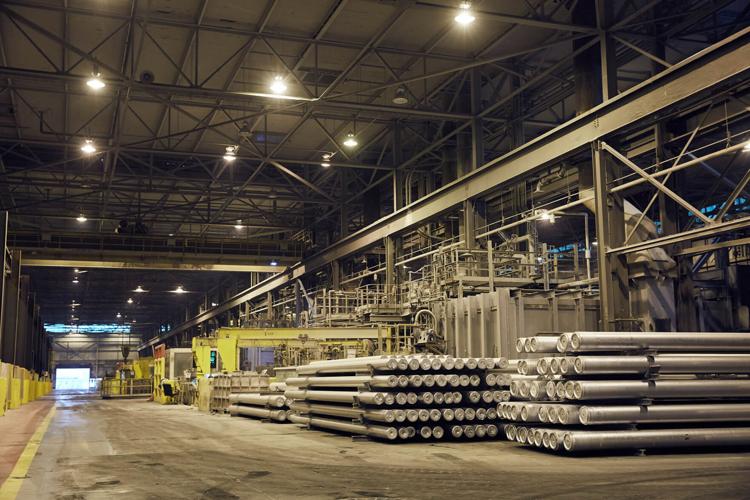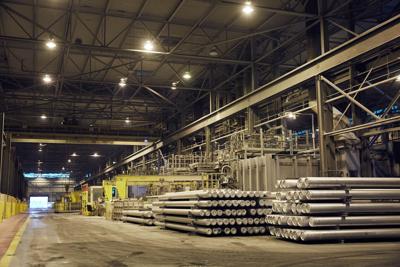A Chicago-based aluminum company expects to receive up to $500 million from the U.S. Department of Energy for the construction of a new aluminum smelter, with eyes on northeastern Kentucky as the possible location.
Gov. Andy Beshear announced on Monday that Century Aluminum Co. could bring roughly 1,000 jobs to a region still gutted from the downturn of coal- and steel-based employers.
Initial reports state Beshear called the company’s intentions a “gamechanger” for the Appalachian region. A specific location has not been disclosed.
Century Aluminum also announced on Monday the company’s selection by the U.S. Department of Energy to begin award negotiations for up to $500 million as part of the federal Industrial Demonstrations Program aimed at “slashing greenhouse gas emissions” while providing stable and high-paying careers.
The company’s release says Century Aluminum is one of 33 projects to “receive funding designed to demonstrate commercial-scale decarbonization solutions needed to move energy-intensive industries” as part of federal funding from Bipartisan Infrastructure Law and Inflation Reduction Act.
With northeastern Kentucky consisting of mostly economically distressed counties suffering from high poverty and unemployment rates, the announcements present a ray of optimism from the rubble of former blast furnaces and long-closed mining operations.
However, the optimism is skewed with a sense of déjà vu, as the region has heard a familiar story resulting in con and a sour taste from broken promises.
So that begs the questions: who is Century Aluminum and why aluminum?
The Chicago-based company, founded in 1995, currently has ownership of plants in the western end of the state, including Hawesville (Hancock County) and Sebree (Henderson County) as well as Mt. Holly, South Carolina, and international points in Iceland, Jamaica and the Netherlands.
According to Century, the Hawesville location is dubbed the largest facility capable of producing high purity aluminum in all of the western hemisphere, adding the company itself is the largest producer of primary aluminum in the entire country.
In addition to Hawesville, the Sebree location has a production capacity of 220,000 metric tons per year, which, according to the company’s reports to the U.S. Securities and Exchange Commission, Sebree produced 214,000 in 2023.
The high purity productions from the Bluegrass State are used specifically in the country’s defense and aerospace industries and produce vital components in feeding the state’s new battery manufacturing sites under a federal administration emphasizing the transition to clean energy production.
Per the company, the Sebree and Hawesville points are two of only five smelters in all of the United States, making a third smelter feasible as demand for aluminum is at an all-time high.
Since aluminum production is key in vehicle production, airplane components and other rising technologies, combined with the U.S.’s desire to break away from foreign supply — industrial reports suggest a “growing urgency” around domestic and clean aluminum suppliers.
While the demand may indeed be there, supplies were cut state-side when Century’s Hawesville smelter grinded to a halt in August 2022, which has since not reopened.
Within Century’s 2023 year-end financials, the company says production was “curtailed” in Hawesville due to rising energy costs that made functioning costs more expensive than what the plant could bring in.
The Hawesville plant, which employed approximately 500 while fully operational, is still maintained “with the intention of restarting operations when market conditions permit, including energy prices returning to more normalized levels and aluminum prices maintaining levels that can support the ongoing costs and capital expenditures necessary to restart and operate the plant.”
During the plant’s closure, Century negotiated labor agreements for unionized Hawesville employees to “cover the curtailment period” through 2026.
Per SEC documentations, the company stated a restart of operations in Hawesville depend on “certain market assumptions that would be subject to risks outside of our control,” relating to global market prices, availability of materials and metal premium prices, adding “changes in these inputs may also make the restart of Hawesville operations uneconomic.”
The company also offered no guarantee of restarting the plant at all, as the above mentioned “unforeseen” issues could increase re-starting costs, delaying the project or squashing it entirely.
A permanent closure of Hawesville, according to Century, “could have a material adverse effect on our business, financial position, results of operations and liquidity.”
Prior to Hawesville’s curtailment, in 2020, Century opted to curtail some operations at their South Carolina smelter with an annual production capacity of about 230,000 tons per year.
By the end of 2020, the company began a “multi-year project” to restore production in South Carolina, returning the location to 75% capacity by the end of 2022.
Despite the restoration in South Carolina, the company reported a nearly $600 million decrease in net sales at the end of 2023 compared to the end of 2022, partly due to the curtailment of Hawesville, which slashed the companies sales nearly in half, and “unfavorable” local and global prices of aluminum.
With sales down and two plants not functioning to full capacity, the possible $500 million and tax incentives for clean energy production may boast the company’s pursuits to “build the first new U.S. primary aluminum smelter in 45 years,” which Beshear said could touch down in this area.
Via Monday’s release from Century, the company said the new plant would be “historic” and “double the size of the current U.S. primary aluminum industry,” estimating nearly 1,000 jobs.
The United States currently contributes just 2% of the global market while China produces more than half, although in 2000, the U.S. was reported as the largest global producer.
The U.S.’s lean toward foreign production is believed to problematic, as the aluminum supply is globally dependent on countries (China and Russia), “that show no substantive signs of cleaning up their industry,” as reported.
As demand increases for clean production and self-sufficiency in aluminum production, other reports question why production is “hobbling” in the state during “the exact moment it should be taking off.”
Although the status of Hawesville could appear bleak, the $500 million announcement suggests a beacon of optimism may prove worthwhile with a Wall Street perspective.
Current stocks show Century Aluminum Company with a one-day 8% jump due to a “new smelter at a site in the Ohio-Mississippi River Basins” and award negotiations pending.
As mentioned, with 1,000 potential union positions and nearly 6,000 construction jobs, reports from the stock market show Century’s stock at its highest level in two years — up almost 60% from last year, according to The Wall Street Journal.
Century’s CEO, Jesse Gary, who joined the company in 2010 and took the senior position in 2021, stated Monday, “We are extremely proud that the DOE has selected Century’s Green Aluminum Smelter Project to receive such significant support, and we are excited to continue moving this transformational project forward.”
As the region focuses on financial stability and securing investments, the availability of training sites and trade school emphasis, the area is teeming with a work force long overdue for local and quality employment.
Century says it “plans to collaborate with job training organizations and local technical colleges to recruit and train employees from the local community where the smelter is located.”



















